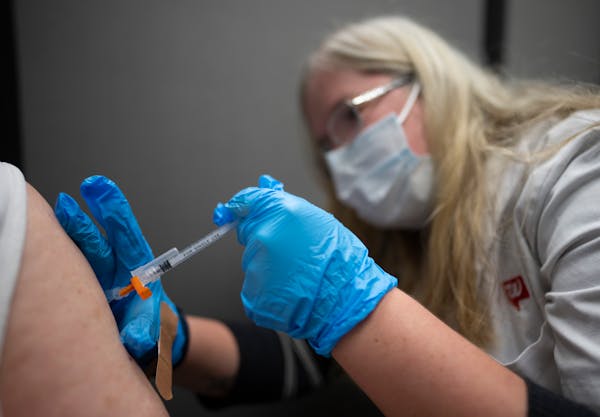COVID-19 surged in September in each of the past two years in Minnesota, but Thursday's weekly state update showed little change for better or worse so far this fall.
Minnesota averaged about 800 to 900 coronavirus infections per day in September, down from 1,300 to 1,400 per day this summer. The 449 COVID-19 hospitalizations in Minnesota on Tuesday represented a slight increase from the average of 430 since August.
Health officials remain concerned that COVID-19 could surge again, just as it did last fall when a severe delta variant of the coronavirus emerged. At this point last year, COVID-19 hospitalizations had already risen above 800 in Minnesota. But for now, the pandemic is behaving like an endemic of low-level but persistent infections.
"We had these quite wild oscillations for a long while, and now we seem to be in a more steady period," said Dr. Frank Rhame, a virologist with Minneapolis-based Allina Health.
Predictive measures show little sign of change. Mayo Clinic's 14-day forecast shows only a modest decline in infection levels in Minnesota and no change nationally.
Viral levels in wastewater have increased slightly in the Twin Cities area and southeastern Minnesota as of Oct. 2 but not in the rest of the state, according to data published by the University of Minnesota.
Wastewater monitoring is an effective predictor of COVID-19 activity, because it isn't affected by changes in testing numbers. The state's COVID-19 case numbers only reflect tests at centers or clinics and not any at-home results that aren't reported publicly.
The U wastewater data for the metro area is based on results from 13 fringe communities such as Northfield and Cambridge. Viral levels found at the Metropolitan Wastewater Treatment Plant in St. Paul are updated on Fridays; last week, the plant reported a 5% decline in viral load.
Minnesota's COVID-19 death toll increased this week to 13,325. The state has averaged four to six COVID-19 deaths per day since mid-May.
Death risks increased among younger adults during last fall's delta wave — particularly among unvaccinated Minnesotans — but the risks this fall are concentrated among seniors. Among 50 COVID-19 deaths in the last two weeks of September, 46 involved seniors and the rest involved adults 50 to 64.
Even in this higher-risk population, COVID-19 deaths seem murkier now, said Dr. Dimitri Drekonja, an infectious disease specialist with the Minneapolis Veterans Medical Center. The infectious disease was the obvious primary cause earlier in the pandemic, whereas now it can be one of several causes playing compounding roles in deaths.
"We're in a way, way better place," he said. "I think everyone in health care does a little internal eye roll when people say 'it's over,' though. It's a rolling, low-level burn right now instead of a wildfire."
Vaccination activity remains tepid in response to the flat levels of COVID-19 activity.
More than 3.5 million Minnesotans 12 and older completed the initial series and are considered fully vaccinated. However, only 285,000 are up to date, meaning they just completed the initial series or have received recommended booster doses to restore immunity.
New boosters with enhanced protection against the dominant BA.5 and BA.4 coronavirus strains are currently recommended for fully vaccinated people 12 and older.
Rhame encouraged a "protect granny" philosophy of low-risk people getting vaccinated and boosted to reduce their risk of spreading the virus.
"How many of us never see an old person?" he asked. "How many of us don't visit granny every once in a while? You don't want to give granny COVID."
The rate of infections during the past two months has been slightly higher in non-elderly adults who received boosters than those who are unvaccinated, according to the latest state breakthrough data. Deaths and hospitalizations remained more common among unvaccinated adults, though.
Rhame said he wasn't surprised by the infection trend, partly because the vaccinated population includes people with outdated boosters and waning immunity levels. Widespread vaccination also is placing pressure on the virus, which evolves to survive and escape that pressure, he added.
"There's substantial waning over three to six months in those antibody levels" after vaccination or prior infection, he said. "So I think what we've got here is a pathogen that we are not capable of producing durable immunity against and which is mutating to beat the band."
The hope is that mutations will slow when the coronavirus "optimizes" into a form that easily spreads to humans but causes less severe illness, he said. "I don't think it has yet, and I think we're going to see more changes."
Carolyn Parnell, 'trailblazer' who served as Minnesota's first IT commissioner, dies


